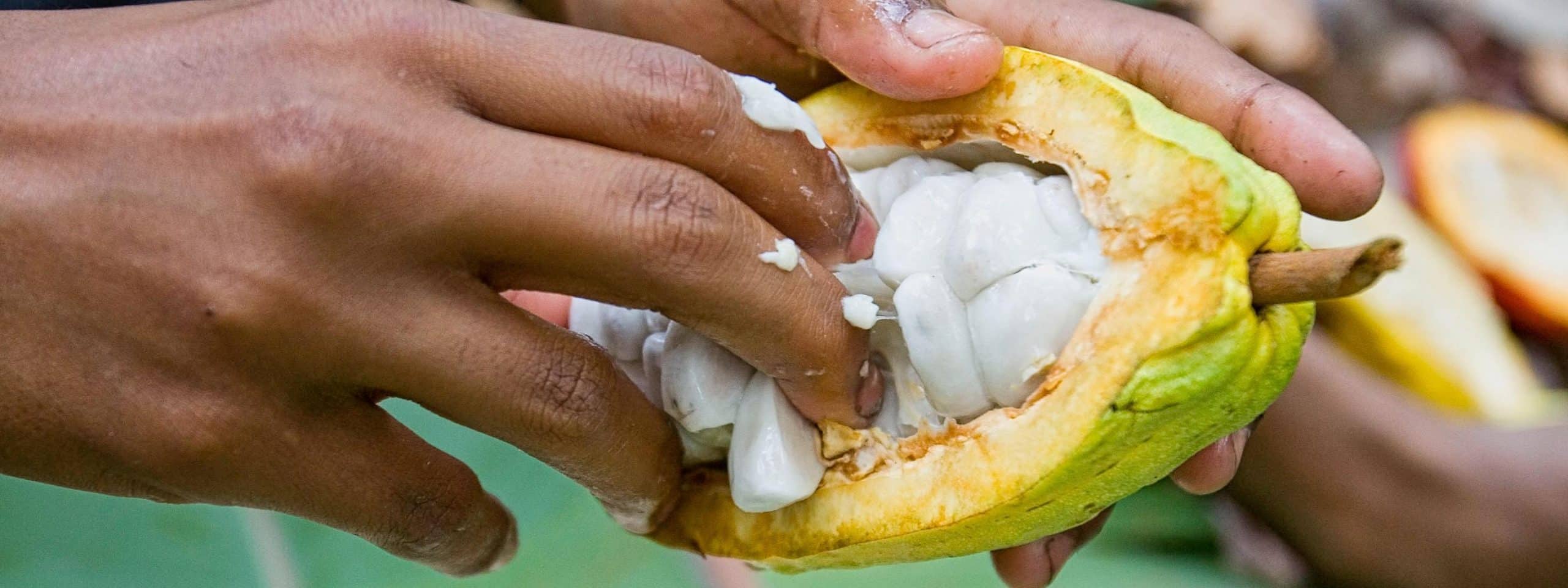
Communicating the sustainability of craft chocolate in a sustainable way
Amsterdam’s lively cacao fair Chocoa returned after a two-year absence. It was a sweet meet & greet with like-minded peers. There was plenty of time to share some interesting insights, to discuss some promising foresights, to evaluate some valuable lessons learned, and of course to taste some delicious cacao and chocolate.
Katrien, founder & co-owner of silva cacao, was one of the keynote speakers of Chocoa 2022, together with Simran (Kokoa Kamili), Vera (Into Choc) & Jeffrey Lee (Cult de choco), and moderators Nick Baskett (Bartalks) and Nick Davis (One One Cacao), in the session on “How to Communicate the Sustainability of Craft Chocolate”.
Are you ready for some inspiring Insights, some time-saving Take Aways and a few bold Heads Up?
Same, Same, Same
- Sustainability is no longer the exclusive preserve of craft products. Nowadays it’s embraced by both industry & craft.
- Sustainability is a ‘buzz word’ aka ‘container concept’, with often no real genuine meaning.
- Origin chocolate is not a guarantee on sustainability, and not special anymore in the EU. Any given EU supermarket has a broad range of origin bars. While a bar might have origin(al) storytelling, the communication is often lacking real meaning or authenticity.
- The craft sector is different in approach, in quality and in authenticity, therefore also needs to communicate differently.
- It has become difficult for many well-intentioned consumers to distinguish between craft and industrial companies and products. Slapping a nice-sounding label on a product as a means to benefit from the appearance, not necessaritly means that the works is done. That challenge is compounded by a lack of knowledge around what all those nice-sounding labels of apparent eco-friendliness and socially responsible actually means
- On the bright side, a research study show that 13% of consumers believe the sustainability efforts of multinationals, while 46% is more tended to belive the sustainability efforts of local comanies.
- Gen Z (people born after 1997) cares more about sustainability than anyone else – and is starting to make others feel the same. Since 2019, as more Gen Z’ers have matured into young adults, their collective voice has become a greater force within the world at large, they are profoundly committed to making choices that align with their values. Often these choices put the health of the planet first, include cutting down on consumption, reducing one’s carbon footprint, supporting small batch producers and local businesses, … Generation Z does not only cares about the ingredients used, Gen Z is the most likely to make purchase decisions based on values and principles of the company (personal, social, environmental such as packaging, energy use,..). Moreover, If brands are not authentic, Gen Z will be the first to raise a red flag.
- Craft chocolate communication can embrace the needs of the future generation.
Dare to be different
The craft niche is surely different in approach and quality. We highly recommend to ‘walk the talk’. Craft chocolate brands’ communication should be transparent, relevant and honest !
- Transparent: Openly sharing info. You can share information on your sources, farmers, an so on. Show your consumers that you actually know you chain partners, their company structure and the supply chain. This creates trust
- Relevant: What does the info you are communicating mean to your audience? What is in it for them? Does it impact their lives in any meaningful way? Or, is it simply information for information’s sake?
- Honest: ‘Do what you say, and say what you do’. Don’t talk about things you don’t understand or you can’t contextualize!
What about consumers’ willigness to pay more for sustainable products?
90% of today’s consumers expect companies to provide environmental and socially responsible products that are authentic and have a positive impact on the planet. Yet more than 50% is still hesitant to pay more for sustainable products, shows a European recent study. They rather pay an extra for natural, healthy and organic products. The Price-point is still a major driver in the purchase decision when buying (sustainable) products
The amount of products with sustainability claims has significantly increased the last 3 years. But, these claims can often not be substantiated, have ‘gaps’, or are not to be trusted. A true ‘greenwashing risk! Many people are claiming ‘sustainable’ but there is so much complexity in this. Labels can be marketing tools but people also need to understand the meaning. So there is a challenge for brand communication to be simple for consumers, to be transparent, but also to meet robust standards and ‘quality of information’. It is important to educate consumers on what really matters.
‘Go Green’ & ‘Plant based’ chocolate emerging as Consumer Sweet Spot. Consumer’s perception of chocolate as a functional indulgence has made it a prime target for plant-based and vegan innovations. Plant-based chocolate is both a modern invention and a centuries-old recipe at the same time.
 Inspiring Insights
Inspiring Insights
Consumers still largely decide on emotions, brand identity, quality & price. That’s why we highly recommend to focus on quality as your main differentiator.
There is an opportunity for the craft to differentiate on sustainable topics, but it requires work and a genuine interest in every single action you take. Credibility is key in your communication, and craft cacao can differentiate on sustainability efforts with transparent, relevant and honest communication.
Show that your company is committed to drive change and take action. Engage your consumer to be part of the journey.
Tasty Take Aways & Bold head’s up
The Key ‘Do’s & don’ts’ for credible communication and creating an authentic engagement with your customer
DO
- Go beyond the cacao bean. Do not only talk about all the ingredients, but inform your audience about your packaging, about your use of energy, about your company identity, your values, …
- Bet on the cacao bean (quality-wise and sustainability-wise). Select your cacao bean supplier careful, check their knowledge on the origins, the personal connection they have with the farmers, and the trustworthiness of their information – You depend on their knowledge and information.
- Communicate your differentiation: your largest differentiator is quality, but next to this you have a short and traceable value chain. Talk about all partners in the chain from bean to bar. For specialty cacao, often fixed and higher prices are paid, decoupled from the commodity price. This creates stability and is the basis tot start talking about sustainability
- Substantiate & document your claims, by mentioning your sources and references
- Educate people. Grow interest & curiosity of your consumers, and trigger their engagement.
- Show commitment and ‘Walk the Talk’
DON’T
- Do not overestimate your social, environmental and economic impact. Be aware of your size. Your personal impact may be small. Specialty cacao as ‘stand alone’ is possibly not sustainable for the farmer (they might need more volume).
- Be especially careful when talking about your “impact” in the origins. To talk about impact you need scale, comparison over time, and smart measurables.
- Avoid generic and hollow “buzz” words – such as sustainability – because you risk of being accused of “greenwashing”. Be careful about your selection of words.
- Don’t communicate with organic certification as a solution for complex issues.
- Be careful with sharing cacao price info. Question yourself if this information is relevant and crucial for consumer? Can the consumer interpret the information? Does the farmer wants the prices to be communicated?
- Do not share info which is not relevant, or info that needs context to interpret correctly or could raise more questions.
- Do not pretend to solve complex global issues such as climate change, child labor, poverty,…
Round up
We can conclude that craft chocolate makers have a huge potential to authentically connect and engage with their consumers to grow the market. When it comes to sustainability it requires a proper strategy on transparent, honest and relevant info.
But most importantly don’t forget to enjoy the journey. Inspire and get inspired by the thriving cacao and chocolate community, and HAVE FUN!


